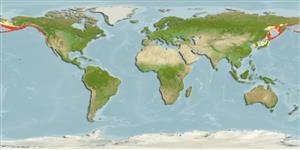>
Pleuronectiformes (Flatfishes) >
Pleuronectidae (Righteye flounders) > Pleuronectinae
Etymology: Lepidopsetta: Greek, lepis = scale + Greek, psetta = grouper (Ref. 45335); bilineata: Specific name refers to the bifurcate supratemporal branch of the lateral line (bilineata = two-lined)..
More on author: Ayres.
Environment: milieu / climate zone / depth range / distribution range
Ökologie
seewasser demersal; tiefenbereich 0 - 575 m (Ref. 6793), usually 0 - 183 m (Ref. 6885). Temperate; 67°N - 34°N, 124°E - 119°W (Ref. 54562)
North Pacific: Baja California to the eastern Aleutian Islands and extreme southeastern Bering Sea.
Length at first maturity / Size / Gewicht / Alter
Maturity: Lm 34.7, range 31 - ? cm
Max length : 58.0 cm TL Männchen/unbestimmt; (Ref. 6885); 60.0 cm TL (female); max. veröff. Gewicht: 1.8 kg (Ref. 56370); max. veröff. Alter: 26 Jahre (Ref. 55701)
Kurzbeschreibung
Morphologie | Morphometrie
Rückenflossenstacheln (insgesamt): 0; Rückenflossenweichstrahlen (insgesamt): 65-82; Afterflossenstacheln 0; Afterflossenweichstrahlen: 50 - 65; Wirbelzahl: 39 - 42. Dorsal origin over forward part of eye. Caudal with posterior margin a broad 'V'. Pectorals small and may be asymmetrical (Ref. 6885). Blind side white, with glossy highlights along myotome margins, increasing anteriorly. Pores: supraorbital 3-9; preopercular 5-7; lateral line 70-91. Interorbital space narrow (Ref. 37594).
Adults occur over sand and gravel substrates to depths of 339 m; larvae collected over depths less than 1,000 m (Ref. 37594). Feed on mollusks, polychaete worms, crustaceans, brittle stars, and fishes (Ref. 6885). A tasty food fish; in some years commercial catch in Canada reaches 3,000 t (Ref. 2850).
Vinnikov, K.A., R.C. Thomson and T.A. Munroe, 2018. Revised classification of the righteye flounders (Teleostei: Pleuronectidae) based on multilocus phylogeny with complete taxon sampling. Molecular phylogenetics and evolution, 125:147-162. (Ref. 122998)
IUCN Rote Liste Status (Ref. 130435)
Bedrohung für Menschen
Harmless
Nutzung durch Menschen
Fischereien: kommerziell
Mehr Information
ReferenzenAquakulturAquakultur ProfilZuchtlinienGenetikElectrophoresesVererbbarkeitKrankheitenVerarbeitungNutrientsMass conversion
PartnerBilderStamps, Coins Misc.LauteCiguateraGeschwindigkeitSchwimmstilKiemenoberflächeOtolithsGehirngrößeSehfähigkeit
Tools
Zusatzinformationen
Download XML
Internet Quellen
Estimates based on models
Preferred temperature (Ref.
123201): 1.5 - 10.1, mean 5.1 °C (based on 1427 cells).
Phylogenetic diversity index (Ref.
82804): PD
50 = 0.6250 [Uniqueness, from 0.5 = low to 2.0 = high].
Bayesian length-weight: a=0.00912 (0.00538 - 0.01546), b=3.08 (2.93 - 3.23), in cm total length, based on LWR estimates for this species & (Sub)family-body (Ref.
93245).
Trophic level (Ref.
69278): 3.2 ±0.2 se; based on diet studies.
Generation time: 9.2 (7.3 - 12.2) years. Estimated as median ln(3)/K based on 10
growth studies.
Widerstandsfähigkeit (Ref.
120179): niedrig, Verdopplung der Population dauert 4,5 - 14 Jahre. (K=0.15; tm=9; tmax=26).
Prior r = 0.27, 95% CL = 0.17 - 0.45, Based on 1 stock assessment.
Fishing Vulnerability (Ref.
59153): Moderate vulnerability (44 of 100).
Climate Vulnerability (Ref.
125649): Low to moderate vulnerability (33 of 100).
Nutrients (Ref.
124155): Calcium = 28.9 [11.9, 52.6] mg/100g; Iron = 0.253 [0.129, 0.481] mg/100g; Protein = 16.9 [15.5, 18.2] %; Omega3 = 0.339 [0.170, 0.691] g/100g; Selenium = 21.7 [11.4, 44.7] μg/100g; VitaminA = 8.11 [1.89, 34.32] μg/100g; Zinc = 0.447 [0.303, 0.655] mg/100g (wet weight);
